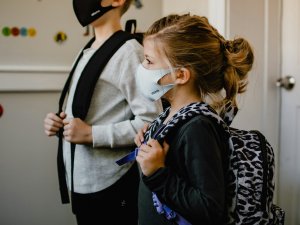Respiratory physician Lutz Beckert considers chronic obstructive pulmonary disease management, including the prevention of COPD, the importance of smoking cessation and pulmonary rehabilitation, and the lifesaving potential of addressing treatable traits. He also discusses the logic of inhaler therapy, moving from single therapy to dual and triple therapy when indicated, as well as other aspects of management
Winter ills hard to shake and perinatal stats gasp-inducing
Winter ills hard to shake and perinatal stats gasp-inducing

The Government’s decision to remove COVID sick leave for health workers is questionable, when mask-wearing is low and winter ills are flourishing. Also a shock is reading the latest statistics on perinatal mortality, writes deputy editor Patrice Dougan
The worst part is how many of these deaths could be mitigated if ethnic and socioeconomic disparities were addressed
Winter is officially here – and I don’t mean the cold snap we’ve been experiencing lately (frost in Auckland!). The seasonal ills have arrived and people around me are dropping like flies. Colds; flus; hand, foot and mouth; and COVID-19 have all raised their ugly heads in my family, friends and work circles. And colds and coughs seem to be worse, they’re lingering – taking people out for days, followed by a long tail.
The fun and excitement of being at a social event is constricted somewhat when you enter a packed building – like a school hall Matariki event or medical conference – and the stuffy heat hits you and you think, I should have worn a mask.
But hardly anyone is. You can count on one hand the number of people wearing masks at events nowadays, even at the medical conferences. I usually spot a few people wearing masks at the mall on my days off, and a couple of the supermarket checkout staff wear them, but it is a rarity these days. It’s funny how we moved so quickly from everyday mask use to it being an exception.
And it shows.
We’re slowly emerging from a sixth wave of COVID-19, which hospitalised 55 people a day at its peak. New Zealand has now had 2.6 million cases and 4216 deaths in total.
Health workers are at the coalface of exposure to these viruses – a number of sessions were cancelled or rearranged at the recent Rotorua GPCME after speakers came down with COVID-19 – but now COVID-19 sick leave for health workers has been scrapped by Te Whatu Ora and a proposal to cut sick leave for part-time workers is on the cards later this year. Workplace relations minister Brooke van Velden says this will “better reflect how much an employee works”.
Health workers are at the coalface of exposure to these viruses – a number of sessions were cancelled or rearranged at the recent Rotorua GPCME after speakers came down with COVID-19 – but now COVID-19 sick leave for health workers has been scrapped by Te Whatu Ora and a proposal to cut sick leave for part-time workers is on the cards later this year. Workplace relations minister Brooke van Velden says this will “better reflect how much an employee works”.
The sick-leave policies coincide with a push for higher attendance at schools, with weekly reporting of pupils’ attendance, despite associate education minister David Seymour noting that short-term illness or medical reasons were the largest contributors to school absences. Sickness absences have increased since pre-COVID-19, Mr Seymour says, but instead of seeing this as a direct result of having SARS-CoV-2 in the community or a positive that people have learned to stay home when contagious, Mr Seymour says the pandemic has changed “attendance culture and what is being considered acceptable”. He has issued guidance to parents to help them decide whether their child is well enough to go to school. It’s pretty standard fare, and no different to the advice schools and daycares already give to parents.
The worry is whether the push for higher attendance means kids start being sent to school when they really should be at home. Teachers don’t want sick kids in class. Nobody wants a sick colleague sitting beside them in the office, a coughing, spluttering hospitality worker serving their food or making their coffee, or a sick doctor or nurse treating their vulnerable relative.
People need to stay home when they’re sick and take time to recover. And sick leave needs to reflect that.
Separately, the recent report into perinatal and maternal mortality (see page 11) made for sad reading, particularly since there has been no improvement in 15 years. “Reporting these disparities over a long period of time has not resulted in any meaningful action to address them,” says John Tait, chair of the Perinatal and Maternity Mortality Review Committee, about the ethnic and socioeconomic disparities in perinatal mortality rates
In 2021 there were 707 perinatal-related deaths – the highest in more than a decade – with people living in deprivation quintile 5, and Indian, Pacific and Māori women overrepresented.
I have a lot of positives to say about the maternity system in New Zealand – the dedicated midwife throughout one’s pregnancy, birth and six weeks’ postpartum before being transitioned to a specialist early years health provider in Plunket is a great system. And quite unfathomable to my friends and family who gave birth in the UK system.
My two births were positive and reasonably uneventful. But that’s certainly not the case for everyone, and this report shows us the stark reality of when things go wrong. The worst part is how many of these deaths could be mitigated if ethnic and socioeconomic disparities were addressed: “If the mortality rates for Māori were the same as those for the composite European ethnic group, 47 more babies of māmā Māori would have survived in 2021,” the report says.
We know there’s a huge shortage of midwives, and like a lot of the health workforce they’re overworked and underpaid. More effort needs to be made to address the disparities that lead to these shameful figures. Dr Tait and his committee have called for more funding and to urgently prioritise equity. Let’s hope someone is listening, this time.
TELL US WHAT YOU THINK
You can add your comments using the comment function below, or by sending a Letter to the Editor to editor@nzdoctor.co.nz
We're publishing this article as a FREE READ so it is FREE to read and EASY to share more widely. Please support us and our journalism – subscribe here
One of the benefits of subscribing is you will also be able to share your thoughts about what you read with others in our Comment Stream. You can also take notes on what you read with Capture


![COVID RAT test on stack of masks CR Guido Hofmann on Unsplash]](/sites/default/files/styles/cropped_image_4_3/public/2024-02/COVID%20RAT%20on%20stack%20of%20masks%20%5BGuido%20Hofmann%20on%20Unsplash%5D.jpg?itok=SSr7Hasr)






![Barbara Fountain, editor of New Zealand Doctor Rata Aotearoa, and Paul Hutchison, GP and senior medical clinician at Tāmaki Health [Image: Simon Maude]](/sites/default/files/styles/thumbnail_cropped_100/public/2025-03/Barbara%20Fountain%2C%20editor%20of%20New%20Zealand%20Doctor%20Rata%20Aotearoa%2C%20and%20Paul%20Hutchison%2C%20GP%20and%20senior%20medical%20clinician%20at%20T%C4%81maki%20Health%20CR%20Simon%20Maude.jpg?itok=-HbQ1EYA)
![Lori Peters, NP and advanced health improvement practitioner at Mahitahi Hauora, and Jasper Nacilla, NP at The Terrace Medical Centre in Wellington [Image: Simon Maude]](/sites/default/files/styles/thumbnail_cropped_100/public/2025-03/2.%20Lori%20Peters%2C%20NP%20and%20advanced%20HIP%20at%20Mahitahi%20Hauora%2C%20and%20Jasper%20Nacilla%2C%20NP%20at%20The%20Terrace%20Medical%20Centre%20in%20Wellington%20CR%20Simon%20Maude.jpg?itok=sUfbsSF1)
![Ministry of Social Development health and disability coordinator Liz Williams, regional health advisors Mary Mojel and Larah Takarangi, and health and disability coordinators Rebecca Staunton and Myint Than Htut [Image: Simon Maude]](/sites/default/files/styles/thumbnail_cropped_100/public/2025-03/3.%20Ministry%20of%20Social%20Development%27s%20Liz%20Williams%2C%20Mary%20Mojel%2C%20Larah%20Takarangi%2C%20Rebecca%20Staunton%20and%20Myint%20Than%20Htut%20CR%20Simon%20Maude.jpg?itok=9ceOujzC)
![Locum GP Helen Fisher, with Te Kuiti Medical Centre NP Bridget Woodney [Image: Simon Maude]](/sites/default/files/styles/thumbnail_cropped_100/public/2025-03/4.%20Locum%20GP%20Helen%20Fisher%2C%20with%20Te%20Kuiti%20Medical%20Centre%20NP%20Bridget%20Woodney%20CR%20Simon%20Maude.jpg?itok=TJeODetm)
![Ruby Faulkner, GPEP2, with David Small, GPEP3 from The Doctors Greenmeadows in Napier [Image: Simon Maude]](/sites/default/files/styles/thumbnail_cropped_100/public/2025-03/5.%20Ruby%20Faulkner%2C%20GPEP2%2C%20with%20David%20Small%2C%20GPEP3%20from%20The%20Doctors%20Greenmeadows%20in%20Napier%20CR%20Simon%20Maude.jpg?itok=B0u4wsIs)
![Rochelle Langton and Libby Thomas, marketing advisors at the Medical Protection Society [Image: Simon Maude]](/sites/default/files/styles/thumbnail_cropped_100/public/2025-03/6.%20Rochelle%20Langton%20and%20Libby%20Thomas%2C%20marketing%20advisors%20at%20the%20Medical%20Protection%20Society%20CR%20Simon%20Maude.jpg?itok=r52_Cf74)
![Specialist GP Lucy Gibberd, medical advisor at MPS, and Zara Bolam, urgent-care specialist at The Nest Health Centre in Inglewood [Image: Simon Maude]](/sites/default/files/styles/thumbnail_cropped_100/public/2025-03/7.%20Specialist%20GP%20Lucy%20Gibberd%2C%20medical%20advisor%20at%20MPS%2C%20and%20Zara%20Bolam%2C%20urgent-care%20specialist%20at%20The%20Nest%20Health%20Centre%20in%20Inglewood%20CR%20Simon%20Maude.jpg?itok=z8eVoBU3)
![Olivia Blackmore and Trudee Sharp, NPs at Gore Health Centre, and Gaylene Hastie, NP at Queenstown Medical Centre [Image: Simon Maude]](/sites/default/files/styles/thumbnail_cropped_100/public/2025-03/8.%20Olivia%20Blackmore%20and%20Trudee%20Sharp%2C%20NPs%20at%20Gore%20Health%20Centre%2C%20and%20Gaylene%20Hastie%2C%20NP%20at%20Queenstown%20Medical%20Centre%20CR%20Simon%20Maude.jpg?itok=Z6u9d0XH)
![Mary Toloa, specialist GP at Porirua and Union Community Health Service in Wellington, Mara Coler, clinical pharmacist at Tū Ora Compass Health, and Bhavna Mistry, specialist GP at Porirua and Union Community Health Service [Image: Simon Maude]](/sites/default/files/styles/thumbnail_cropped_100/public/2025-03/9.%20Mary%20Toloa%2C%20Porirua%20and%20Union%20Community%20Health%20Service%20in%20Wellington%2C%20Mara%20Coler%2C%20T%C5%AB%20Ora%20Compass%20Health%2C%20and%20Bhavna%20Mistry%2C%20PUCHS%20CR%20Simon%20Maude.jpg?itok=kpChr0cc)